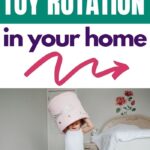Are you overwhelmed by the number of toys your kid has – and the mess they create?
Don’t you wish there was an easier way to manage your child’s toys? A way to make your child’s toys more exciting, encourage their creativity, AND make less of a mess?
Good news: there is an easier way.
And it’s called toy rotation.
Keep reading to learn:
- What toy rotation actually means!
- How toy rotation will benefit your child – and make your life easier.
- How to identify toy rotation categories, create toy rotation storage, and successfully implement toy rotation in your home!
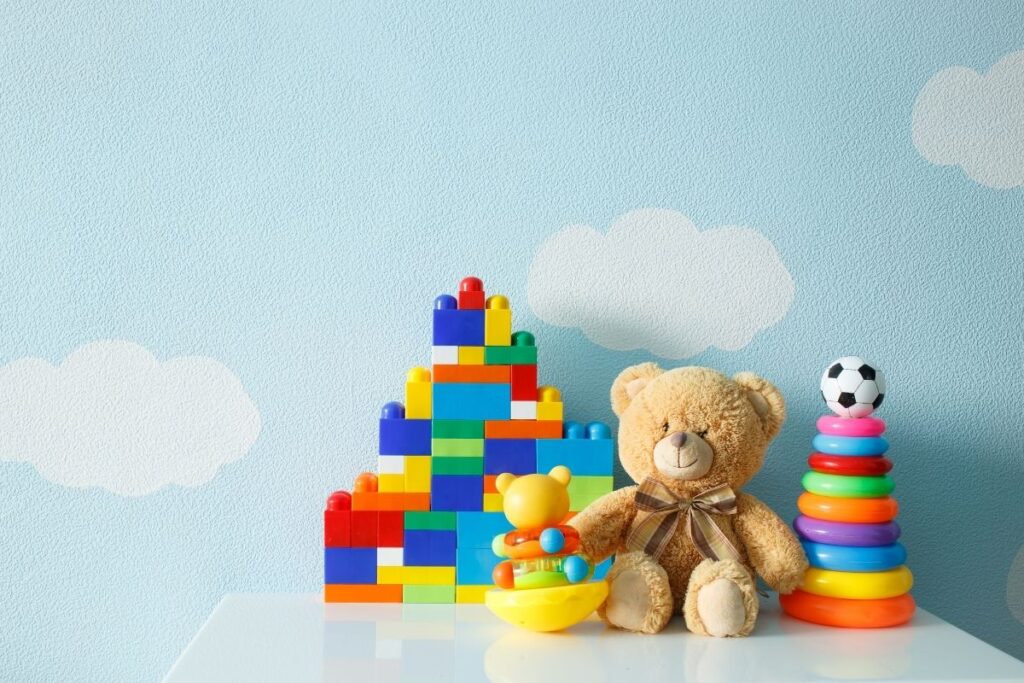
What IS a Toy Rotation Exactly?
Let’s start with the basics. What is toy rotation?
Toy rotation is exactly what it sounds like. It’s the process of rotating the toys available to your child for play. Instead of giving them full access to everything in the toybox or playroom, parents choose a fixed number of toys to keep out. Everything else gets put away.
After a couple of weeks of play with those particular toys, you put them away and pull out a totally new batch of toys to enjoy.
Toy rotation is not an excuse for keeping way too many toys. It’s best to first declutter toys before starting the toy rotation process.
What are the benefits of toy rotation?
There are many reasons families choose to rotate kids’ toys. Not sure why you should try it? Here are some of the biggest benefits families see from toy rotation:
- Toy rotation leads to less clutter and mess, which means less stress for parents AND kids.
- Clean-up becomes a breeze when you’re only dealing with a handful of toys.
- With fewer toys to choose from, your kids will have more appreciation for the toys they CAN enjoy.
… and that’s just the beginning!
Why rotate toys? How does toy rotation help a child’s development?
Now, you might be asking, “WHY on earth would I do that?”
Why would you take toys away from your child instead of encouraging them to play? Isn’t that the whole point?
Well, yes – and no. Believe it or not, there are some compelling reasons to rotate toys for parents AND for kids.
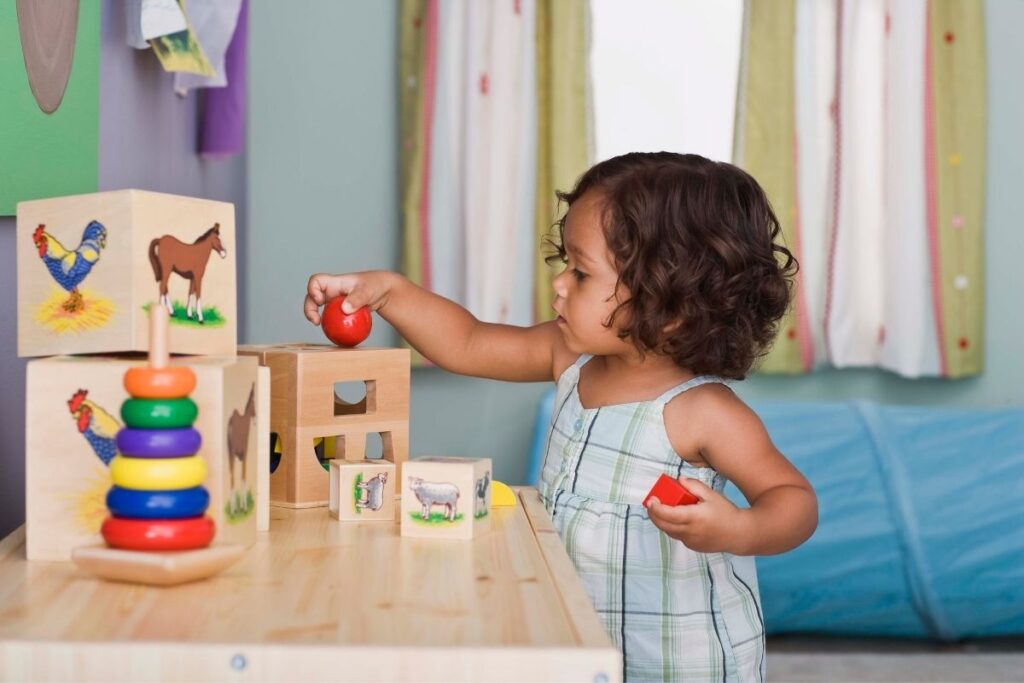
Too many toys can cause toy clutter – and lead to unnecessary stress and overwhelm!
Your child should absolutely have a selection of toys to choose from including toys that suit different play styles, encourage different skills, and spark their imaginations.
But if you’re giving your child access to ALL of those toys at once? There’s a good chance they’re a little overwhelmed.
Having too many toys to choose from can lead to lots of clutter and chaos. That’s not just overwhelming for us as adults. It’s overwhelming for kids, too. Instead of enjoying focused play, too many toys tempt them to bounce between objects, shifting their attention from one thing to the next.
Why Montessori-style toy rotation is a great solution when you have too many toys
Toy rotation is a technique embraced by Montessori-style schools for a reason. They’ve seen the benefits that come from focused play, and they’ve found a way to encourage it.
You can take this same technique and use it at home to keep things fun, fresh, and exciting for your child. By giving them access to a smaller number of toys at a time, they’re forced to focus and get creative which is exactly what you want!
How to set up a toy rotation – and keep it going!
Ready to implement toy rotation in your home?
Great! Here are a few things that every family should consider before setting up a toy rotation at home.
Should you discuss your toy rotation plan with your children?
One of the biggest questions parents ask before implementing a toy rotation plan:
“Do I tell my child?”
Well, that depends. How old is your child? Some kids are simply too young to grasp the concept of toy rotation. If you try to explain what you’re doing to your two-year-old, you probably won’t get very far.
But your five-year-old? They’ll immediately notice the fact that their favorite toys are gone so you want to set some expectations first.
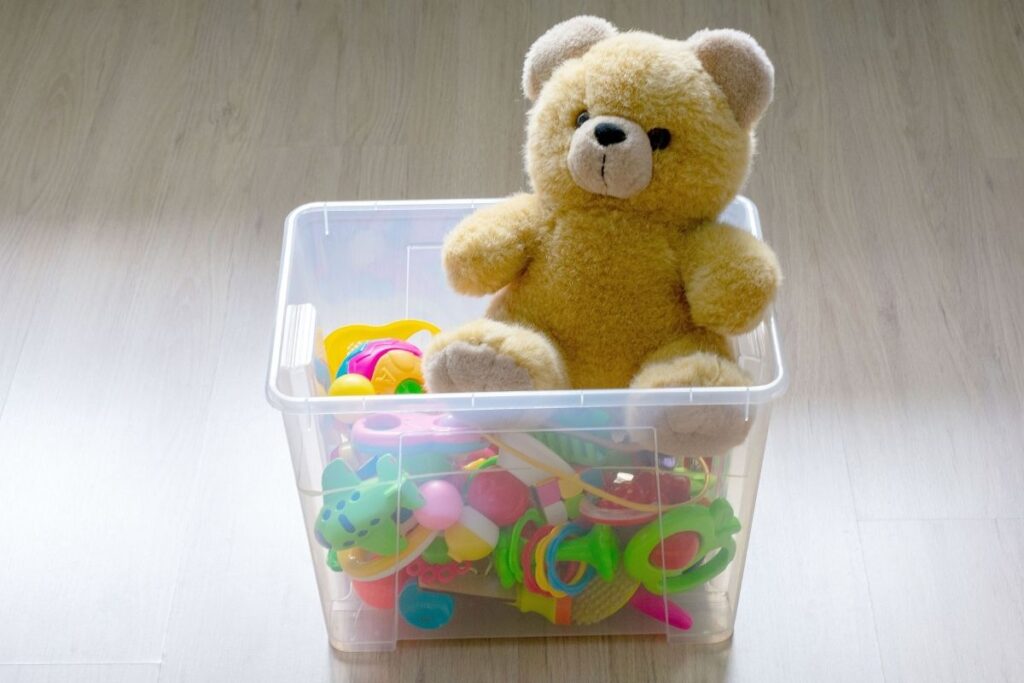
What age should you implement a toy rotation?
The best time to start rotating your child’s toys? As soon as they’re old enough to play with them.
The second best time? Today.
The earlier you start to rotate your child’s toys, the easier it will be for them.
Start when they’re young and they’ll never know any different. This will help you avoid the headache of helping you older children understand why you’re taking their favorite action figures away.
By making toy rotation a normal part of life, instead of a big change that you’re trying out, you’ll have a much easier time making it part of your family’s routine.
How to decide which toys should be put away?
So you’ve decided to rotate your child’s toys – great!
Now, you’ve got to figure out WHICH toys to put away.
Fortunately, it isn’t as challenging as it sounds.
Try to identify 8-10 categories. Then, choose 2-3 categories to keep out for your child – and put the rest away.
My biggest advice here? Don’t overthink it. If you didn’t leave your child’s favorite toy car out for the first rotation, don’t worry, you can include it in the second!
How to set up toy rotation categories.
Toy rotation categories are a great way to make toy rotation super simple.
To start, evaluate your child’s toy collection and come up with a list of categories. Lots of action figures? That’s a category. Construction toys like Lego and wooden blocks? Another category!
By identifying different categories and assigning your child’s toys to those categories, you can guarantee you have a good variety of toys available for play. The last thing you want is to stifle your child’s imagination or discourage creative thinking.
Select a few categories to play with at a time and swap them out by category.
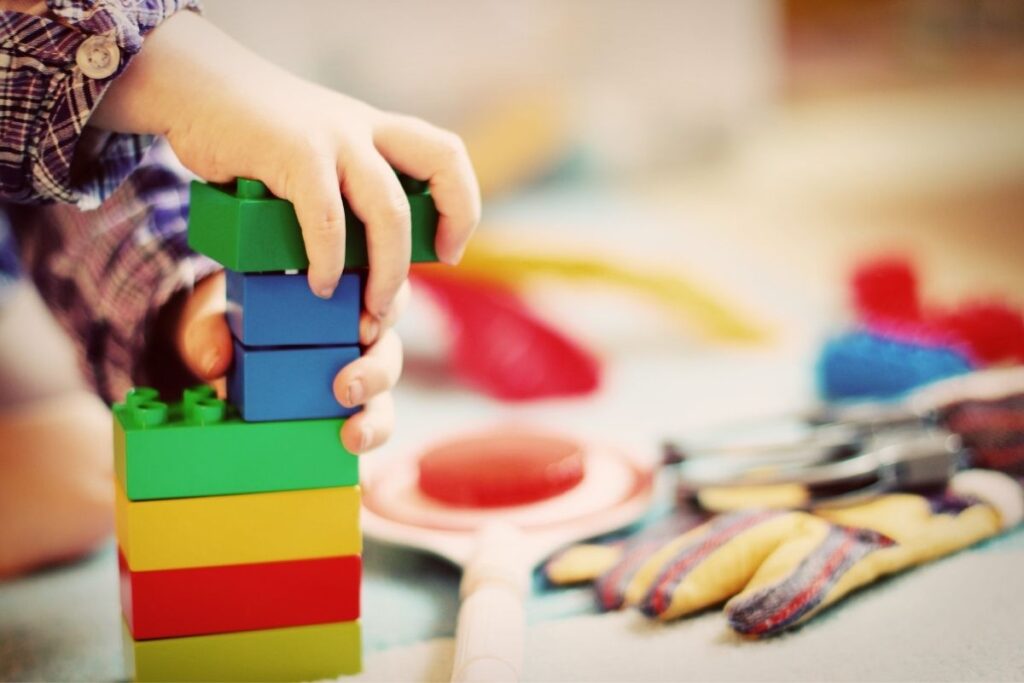
How often should you rotate toys?
When it comes to toy rotation, there’s no one-size-fits-all answer.
Some parents swap out their child’s toys every few weeks. Others change them out more frequently – once a week, or even as often as once per day.
How often you rotate your child’s toys depends on a few factors:
- Your ability to manage their toys
- Your child’s attention span
- The type of toys your child plays with – some provide days of fun, while others get old faster than that.
I recommend starting with a weekly toy rotation and adjusting based on what works for your family.
Where and how to store the toys that AREN’T being used?
Your toy rotation won’t be successful if they’re hidden in the corner of your child’s bedroom.
When toys are out of rotation, they should be out of sight and out of mind. Don’t leave them in your child’s room and tell them they’re off-limits. Instead, they should be moved to a totally different space in the house where they aren’t tempting your child.
Where do you store them? Again, it depends! You can store them…
- In a dedicated closet or spare room that your child can’t access.
- Inside a suitcase or other storage container in your closet
- In your garage or storage area in individual bins, separated by category to make it easy for you to swap out toys in the rotation.
What do I do with bigger toys, like a play kitchen?
Toy storage is a serious subject for families who practice regularly rotating toys.
It’s easy to hide smaller toys, like dolls, games, and toy cars – but what about big stuff?
Toys like doll houses and play kitchens aren’t easy to hide, but you can make it happen. You’ve just got to get creative.
Put it in the garage. Store it in the basement or haul it up to the attic, or hide it in a spot that’s considered ‘off-limits’ like your bedroom closet or the backyard shed.
No good options there? Call a friend or family member and see if they wouldn’t mind holding onto it for a few weeks. If that feels like too much of a hassle, then leave a few select larger toys out that are not included in the rotation.
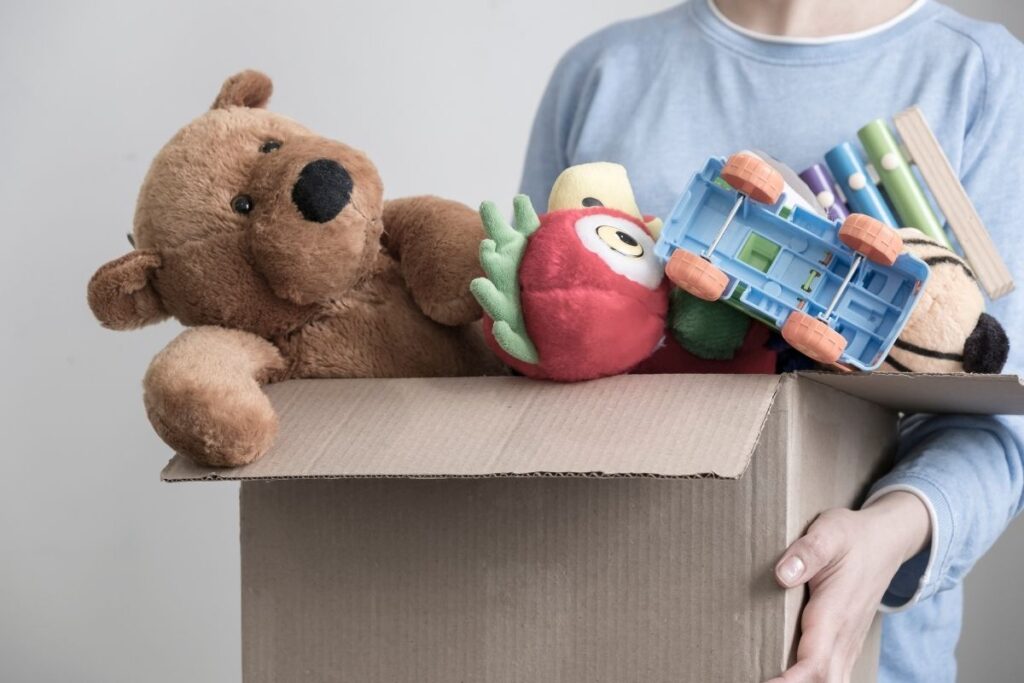
How do you know what toys to rotate in?
Many parents who implement toy rotation also have a hard time knowing when to rotate toys in.
How do you choose which toys to refresh your current rotation with?
You can take a few different approaches here:
- Choose the toys your child has been separated from the longest, so they feel new and exciting.
- Select the toys your child asked for during the prior rotation, so you know they’ll be excited to play with them.
- Choose toys that will encourage a specific type of play.
- Select toys that suit a theme. For instance, if you just watched the movie Cars, it might be a great time to bust out the toy cars and put away the tractor set.
How to implement a toy rotation if you have a playroom.
If you have a dedicated playroom for your child’s toys, you CAN still implement a toy rotation.
Believe it or not, you can take all of the toys out of that playroom – except for the ones you want them to have and everything will be totally fine.
Your child may even be able to enjoy their playroom even more without the stress and overwhelm created by too much clutter and too many options.
The Bottom Line: toy rotation is beneficial for you and your child!
Some parents balk at the idea of taking toys away from their child. But with a little research, it’s easy to see the overwhelming benefits of toy rotation for your child, yourself, and your home.
It can be a simple and easily managed process that helps maintain your child’s interest and also keep excess clutter from piling up in your home.
Want to keep up to date with The Simplicity Habit? Sign up below and get weekly tips on simplifying and decluttering your home and your life. You’ll also get the Your Home Decluttered Jumpstart which includes 100 easy items to declutter and 12 high impact areas to declutter in 10 minutes.

